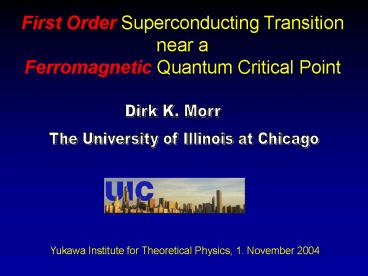First Order Superconducting Transition PowerPoint PPT Presentation
Title: First Order Superconducting Transition
1
First Order Superconducting Transition near a
Ferromagnetic Quantum Critical Point
Dirk K. Morr
The University of Illinois at Chicago
Yukawa Institute for Theoretical Physics, 1.
November 2004
2
Collaborators
- A.V. Chubukov (UW-Madison)
- R. Haslinger (LANL)
- A. Finkelstein (Weizman Institute)
A.V. Chubukov, R. Haslinger, A. Finkelstein, and
D.K.M. Phys. Rev. Lett. 90, 077002 (2003)
Financial Support
- UI Campus Research Board
- Los Alamos National Laboratory
- Alexander von Humboldt Foundation
3
Superconductivity near a Ferromagnetic Quantum
Critical Point
4
Triplet Pairing induced by Ferromagnetic Spin
Fluctuations
5
Origin of the Tc suppression ?
Scattering off classical (?m0) spin fluctuations
leads to divergent self-energies
?m
?m
no cancellation of divergences within a
linearized Eliashberg theory
6
The Spin-Fermion Model
7
The Strong-Coupling Eliashberg Equations
The SC gap ?(?n) is determined via the
Eliashberg-equation
D2 and Heisenberg spin symmetry
8
Feedback effects due to Superconductivity
one has in general
For spin-triplet pairing with dz
9
Thus
- divergences do not permit a small ? (or ?0)
- a solution of the non-linear Eliashberg
equation - exists at T?0 for sufficiently large ?
10
First Order SC Transition and the Phase Diagram
11
Pairing of Incoherent Fermions
Spin excitations give rise to quantum critical
(NFL) dynamics of the fermionic degrees of
freedom
12
Final Remarks
- Spin Symmetry
For an xy- and Ising-spin symmetry, the
divergent self-energies always cancel
13
Conclusions
Feedback effects on the spin-susceptibility are
important in the triplet SC state and lead to
- Emergence of a first-order transition into the
- SC state near the FMQCP
- Non-BCS pairing of incoherent fermions at the
- FMQCP.
PowerShow.com is a leading presentation sharing website. It has millions of presentations already uploaded and available with 1,000s more being uploaded by its users every day. Whatever your area of interest, here you’ll be able to find and view presentations you’ll love and possibly download. And, best of all, it is completely free and easy to use.
You might even have a presentation you’d like to share with others. If so, just upload it to PowerShow.com. We’ll convert it to an HTML5 slideshow that includes all the media types you’ve already added: audio, video, music, pictures, animations and transition effects. Then you can share it with your target audience as well as PowerShow.com’s millions of monthly visitors. And, again, it’s all free.
About the Developers
PowerShow.com is brought to you by CrystalGraphics, the award-winning developer and market-leading publisher of rich-media enhancement products for presentations. Our product offerings include millions of PowerPoint templates, diagrams, animated 3D characters and more.

